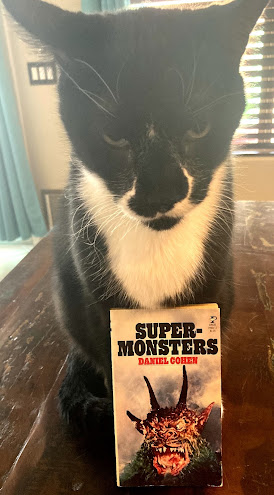The book's cover is memorable but perhaps slightly misleading, as it features the fearsome fiend from the 1957 British horror film Night of the Demon (also known as Curse of the Demon).
Supermonsters covers monsters in movies and popular culture; Dracula, werewolves, mummies and zombies are all discussed. But much of its focus is on the historical origins of those creatures and the strange beliefs associated with them — beliefs that were then twisted and/or co-opted by books and films.
This book was my young self's introduction to the centuries-old tales of Europeans who had (trigger warming: not for the squeamish) little understanding of the science of plagues or how corpses decomposed. And so when they dug up the latter to try to solve the mystery of the former, they came to some very wrong conclusions. Beliefs in vampirism were thus strengthened and propagated across the land.
Supermonsters similarly delves into the myths and misunderstandings that informed modern ideas about other ghoulies. For example, there is the story of Peter Stubb. That's his name in the book, anyway; other historical accounts list him as Peter Stumpp, Peter Stübbe, Peter Stumpf, etc. As Cohen explains:
"Stubb was executed as a werewolf near Cologne, Germany, in 1589. ... Stubb said that the Devil had given him a magic belt made of wolfskin. When he put the belt on, he was changed into a wolf. ... Putting on a wolfskin belt was not the only way of turning into a wolf. One man confessed that he became a werewolf after eating wolf meat. Another said that he drank water that he had collected in the footprint of a large wolf. There was also a magic wolf ointment."
All of this eventually led to the tale of Lawrence Talbot on the silver screen. And that movie version took its own liberties with werewolf legends, adding some of its own out of the imagination of the filmmakers.
Supermonsters also introduced me to some lesser known (by today's standards, anyway) monsters in popular culture. It's where I learned of Nosferatu; Varney the Vampire; Wagner, the Wehr-Wolf; Lon Chaney as the silent and nightmare-inducing The Phantom of the Opera ... and a film that I finally, all these decades later, got around to watching this week: 1920's Der Golem.
If you've never seen Der Golem, I highly recommend it. Personally, I think it's even better than the excellent The Cabinet of Dr. Caligari, which was released that same year. There's an outstanding Blu-ray restoration of Der Golem available from Kino Lorber. I think you'll see, too, how much it inspired some more well-known horror films that came after. For example, I'll leave you with this image from Der Golem...



No comments:
Post a Comment